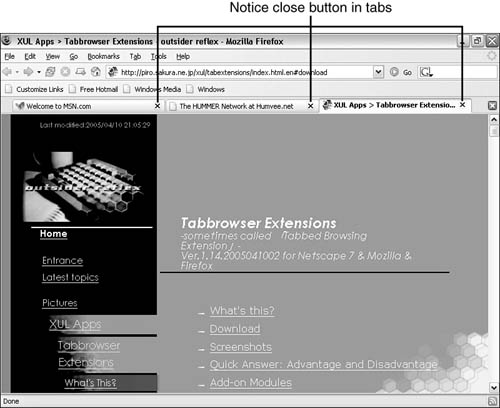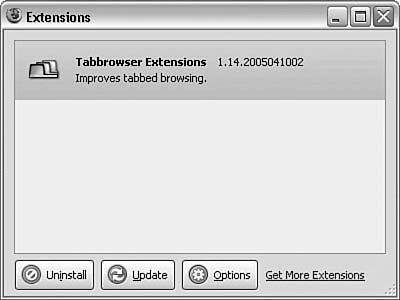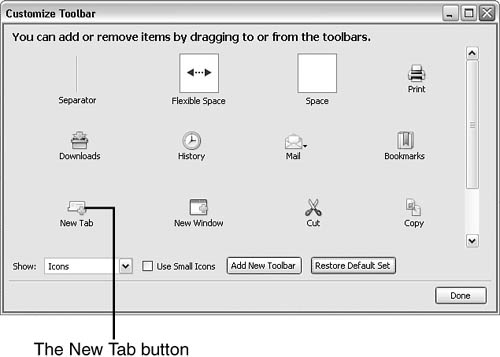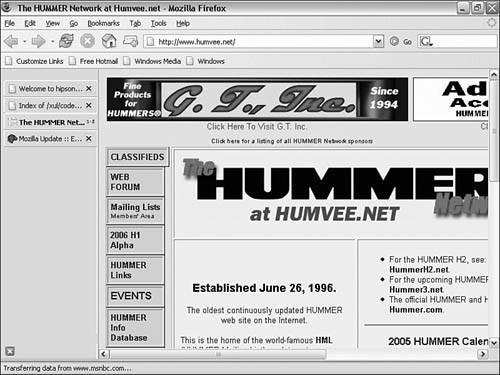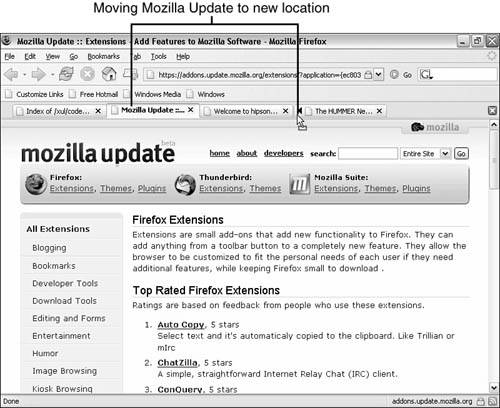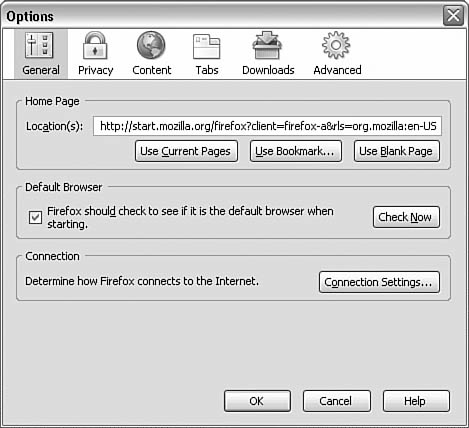IN THIS CHAPTER
Firefox opens the door to some very useful functionality. Tabs allow multiple documents (web pages, for example) in a single Firefox session. Using these tabs is much faster than trying to switch between multiple browser sessions.
Bookmarks enable frequently accessed pages to be quickly selected. Similar to Internet Explorer’s Favorites, the Firefox bookmarks are somewhat more powerful and useful.
This chapter covers using both Firefox’s built-in tab support and Tabbrowser Extensions. In the sections that follow, if Firefox supports a functionality without Tabbrowser Extensions, the differences are also described.
You can open multiple websites in Firefox using tabs, as shown in Figure 2.1.
Firefox’s tabs are relatively simple and, as such, are easy for new users to understand. They are a major step forward in usability. With Firefox’s tabs, you can control the behavior of tabs when a new page is opened and use some simple management options.
To improve on Firefox’s tabs, you can install tab feature extensions that enable you to do more with them. The many tab feature extensions include
Tabbrowser Preferences—. This extension, written by Bradley Chapman, extends the Firefox tab feature. Its enhancements are relatively simple, and the product is stable and easy to use. This add-on lets users customize Firefox’s tabs using a new section named Tabbed Browsing in the Firefox Options dialog box. Tabbrowser Preferences essentially adds more control and customization to tabs, without adding a lot of functionality. Tabbrowser Preferences can be downloaded from http://216.55.161.203/theonekea/tabprefs/.
Tabbrowser Extensions—. Many features make this add-on excellent for both beginning and experienced users. The configuration for Tabbrowser Extensions enables you to specify whether you want features that are intended for experienced users or for novice users. Some of the features Tabbrowser Extensions offers include a throbber for each tab, a close box in each tab, and tab grouping using colors. Tabbrowser Extensions is a much more extensive add-on compared to Tabbrowser Preferences because it adds substantial functionality to the Firefox tabs.
Other interesting features of Tabbrowser Extensions include the capability to switch tabs by hovering the mouse pointer over a tab, tab coloring, and the ability to reopen a tab that had been closed. This program can be downloaded from http://piro.sakura.ne.jp/xul/tabextensions/index.html.en.
Shown in Figure 2.2 is Firefox with Tabbrowser Extensions loaded and active. Notice that the tabs now have a close button in the upper right of each tab. One click to close is all you need! Other features that are not apparent in this figure include the throbber capability, which shows when a page is being loaded, and the load progress. Also visible in Figure 2.2 is the Tab menu item that Tabbrowser Extensions adds to Firefox.
Installing Firefox extensions is generally easy. All extensions are managed with the Extensions Manager, which is displayed when you select Tools, Extensions in the menu. The Extensions Manager is shown in Figure 2.3. If you download the extension, it loads automatically. However, Firefox must be restarted for the extension to become active and available to the user.
In the Extensions Manager is a list of all the installed extensions—the information includes the name, version information, and a short description. The Extensions Manager has three buttons at the bottom: Uninstall, Update, and Options (not all three can be active at the same time, however!). Additionally, a link next to the Options button displays Mozilla’s Firefox Extensions page.
When an extension is loaded, clicking Options enables you to set options for the extension.
Caution
Firefox allows extensions to be installed only from approved sites. This helps protect you from rogue extensions. You can’t automatically install an extension from a site that is not in the approved sites list. To add a site to the approved list, open the Options dialog box, click the Web Features button, and click the Allowed Sites button next to Allow Web Sites to Install Software. Add those sites you trust to this list. You can force Firefox to download any extension by right-clicking the extension and selecting Save Link As. Then you can install an extension by dragging its XPI file (that you have saved on your computer) and dropping it onto the Extensions Manager dialog box.
One great feature of Firefox’s tabs is the capability to drop a link on the toolbar’s new tab or new window buttons. This opens that link in a new tab or window. You also can add a new tab by selecting File, Open Tab in Firefox’s menu. However, there is an easier way to add a new tab—by customizing the toolbar.
Right-click Firefox’s menu and select Customize from the pop-up context menu. Customize allows you to add and modify the toolbars used by Firefox. The Customize Toolbar window is shown in Figure 2.4.
Customizing lets you add and remove buttons from existing toolbars. You can also create a new toolbar if you want. Creating a new toolbar is your choice, but I recommend you add a new tab button to the Navigation toolbar.
Note
Firefox comes with two toolbars by default: Navigation and Bookmarks. Toolbar extensions also can be added to Firefox. One that looks interesting is a Google search toolbar. (Why is this included if Google search is built in? Because users want more power!)
After the Customize Toolbar window has opened (refer to Figure 2.4), you have a choice of a few buttons you can add to toolbars. (Sadly, you can only add them once….) Like many Windows programs, toolbars are customized by dragging a tool to the desired location on the toolbar.
To open a link in a Firefox tab, click the tab and make it active. Then in the Location bar where the current website address is displayed, type a new website address and press Enter. Firefox opens that page in the active tab.
After they’re installed, Tabbrowser Extensions’ preferences can be changed to suit your liking. Click Tab in the menu and, at the bottom of the drop-down menu, click Tabbrowser Extensions Preferences. The Preferences of Tabbrowser Extensions window displays. In this window you can set a number of parameters.
This window is arranged with extension preferences on the left side and settings for the particular option on the right side.
For the initial display (the highest level of options, Tabbrowser Extensions), you have options to save and reload. This is helpful if you want to export your settings to another copy of Firefox.
Tip
Each time you change to a different tab, Firefox updates the Location bar to reflect the URL for the page being displayed. Middle-clicking a link opens it in a new tab and loads the link in the background. By default, the new link opens in the foreground, but Firefox can also be set to load links in the background by unchecking Select New Tabs Opened from Links. This can be more convenient, especially when browsing eBay or Google search result pages because you can keep browsing the results page while the selected links load in new tabs in the background.
Tabbrowser Extensions has about 165 configurable options. These options cover a wide range of functionality. Table 2.1 lists the options, types of value, and typical setting values. I have not attempted to indicate a default value for any options because the defaults change depending on whether you are a novice, professional, or default user.
Table 2.1. Configuring Tabbrowser Extensions Options
Option Subcategory | General Description | |
|---|---|---|
General | Options that affect the general operation of Tabbrowser Extensions and Firefox, such as the use and closing of windows. | |
New Tab | Sets what is displayed when a page is opened and the location for new tabs. | |
Close Tab | ||
Close Window | Specifies what will be done when a window is closed, such as closing all tabs or just the current tab. | |
Undo | Tabbrowser Extensions enables you to undo a tab close action. You can specify the cache size for undo of tabs that have been closed. | |
Use Tab | With this set of options, you control how tabs are used. You can specify actions for both newly created tabs and existing tabs. | |
Links | When the browser opens links found on a page, you can force these links to open in a new tab, an existing tab, or a background tab. You can also specify the additions to the browser’s context menu here. | |
External Links | When opening links in external (other than the browser) applications, you can specify whether the link is to open in the current tab, a new tab, or no control. You also can specify that the browser remain in the background (not get Windows focus) when an external link is opened. | |
Pop-ups | When a page’s script opens a pop-up, you can specify whether you want to open it in a new tab, new back ground tab, or new window. | |
Bookmarks | When you open a bookmarked page, you can choose to have it opened in the current tab, a new tab, or a new background tab. | |
History | If Go, Back, or Forward is selected, you can specify that the link is opened in the current tab, a new tab, or a background tab. | |
Location bar | The Location bar (found on the Navigation toolbar) can be configured to open links in the current tab, a new tab, or a new background tab. | |
Web Search | When doing a web search, the search results need to go somewhere. You can configure the search results to go to the current tab, a new tab, or a new background tab. | |
View Source | Sometimes you want to look at a page’s source HTML. Maybe you want to see how a feature or effect was created. Other times, you might want to find out information that is not displayed. You can configure Firefox to display the viewed source in a new window, a new tab, or a new background tab. | |
The main Appearance option is to turn the display of the Tab menu on and off. | ||
Tab | Remember those close buttons on the tabs shown in Figure 2.2? This option lets you have the close button on all tabs, the current tab, or the selected tab. As well, you can configure the width of tabs and the display of the tab meter that shows the progress of page loads. | |
Tab bar | The tab bar is, by default, on the top of the display area. You can choose to have it on the bottom, have it on either side, or to hide it. When there are too many tabs to display them all, you can choose to scroll or use multiple rows of tabs. | |
Tab menu | This controls the context menu displayed when the user right-clicks the tab bar. Figure 2.5 shows this context menu. Currently not shown in the figure are seven selections that are turned off. | |
Context menu | A few additional menu items can be configured in this submenu. | |
Gestures | You can define the scroll wheel, button actions, and pointing effects relating to the tabs with this selection. | |
Features | This includes a number of features, such as locking, blocking, plug-ins, JavaScript, frames, and autoloading. | |
TabGroups | Tabs can be grouped. That way, tabs that are related (such as a number of pages from a website) can be managed as a group. Tab groups are shown by colors by default. | |
Startup | When Firefox starts, it usually just loads the defined home page. With Tabbrowser Extensions, you can choose to restore the last tab session. This is handy if you have a continuing project and need to have certain pages opened repeatedly. | |
Misc | With this option group, you can choose a different appearance when Firefox is running on Mac OS X. You can also choose to save or restore blank tabs and automatically reload restored session tabs. | |
Management of installed modules can be performed here. |
Now, let’s move on to using tabs and Tabbrowser Extensions.
Tabbrowser Extensions gives you power. When you start with Firefox without Tabbrowser Extensions, you have simple tabbing, where you can create tabs and navigate between tabs using mouse clicks. You can also switch between tabs using Ctrl+Tab.
With Tabbrowser Extensions installed, you can change your tab navigation and make multiple pages much easier to use. Let’s look at some of the options Tabbrowser Extensions gives you.
Navigation between tabs is controlled by some of the options that were described previously in Table 2.1. Switching between tabs can be accomplished either by hovering over the tab or by clicking. This option is set in the Gestures options, shown in Figure 2.6.
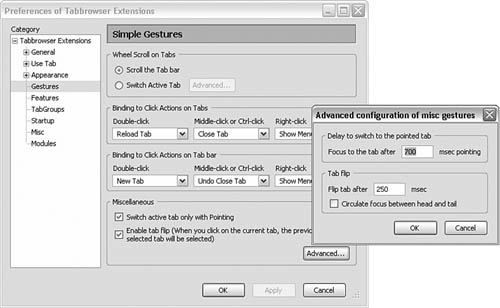
Figure 2.6. Tab navigation is controlled in the Miscellaneous section. There is also an Advanced button to display additional settings.
If the Switch Active Tab Only with Pointing box is checked, hovering the mouse over a tab causes the tab to become the active tab automatically. You won’t have to click. This is most useful when you need to quickly switch between two pages to check information.
Caution
Some users find this behavior to be unsettling! It does lead one to believe that the computer is doing something it was not asked to do! However, I recommend you give it a chance—it will grow on you!
Click the Advanced button to set the focus change delay. The default is 100 milliseconds. (That’s just 1/10 of a second.) This delay enables you to pass over a tab—for instance, to move the mouse to the menu or toolbar from the main browser
window—without a tab change. I’ve found that 100 milliseconds is a bit fast for my liking and usually set it to a slightly higher number. Experiment with numbers between 50 and 1,000 (make changes by about 50 milliseconds at a time) and see what you like.
Automatic switching works well when you configure the tabs to be on the left (see Figure 2.7) or right of the browser window. There is less tendency to accidentally switch between tabs because you don’t have to pass over the tab bar when going to the menu or toolbars.
There are several ways to rearrange your tabs. One is mouse centric, whereas the other is based on the keyboard.
To rearrange tabs, you use a common drag-and-drop technique. Click the tab to be moved, and drag it to the new location on the tab bar.
While the drag is in progress, Firefox indicates the new location with a down-pointing arrow that shows the new location. Figure 2.8 shows a tab being dragged on the tab bar (the down-pointing arrow is not visible in this figure, although it appears directly above the space between the two tabs where the mouse cursor is). Notice the drag cursor position showing where the dragged tab will be dropped.
When you’re using Tabbrowser Extensions and you have your hands on the keyboard, you can move the currently active tab to a new location. This is not as powerful as the drag-and-drop method shown previously because you can move only the current tab, but it is still useful.
To move a tab to the left for the top and bottom tab bars, press Ctrl+Shift+Page Up. To move a tab to the right for the top and bottom tab bars, press Ctrl+Shift+Page Down.
To move a tab up for the left and right tab bars, press Ctrl+Shift+Page Up. To move a tab down for the left and right tab bars, press Ctrl+Shift+Page Down.
I am not sure that these keyboard shortcuts are remembered by anyone, but they are there if needed.
Bookmarks enable you to save page locations you might want to revisit at a later time. I have several hundred bookmarked pages, although I suspect some are no longer valid.
The last item on each bookmark menu is Open in Tabs. Click this and Firefox opens all the bookmarks, each in its own tab. See Figure 2.9 for an example.
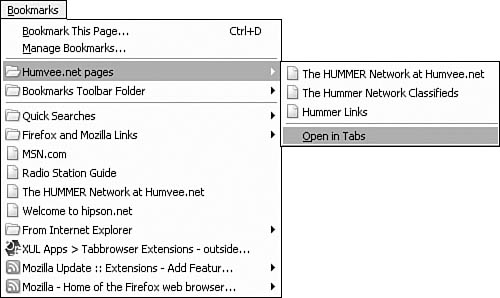
Figure 2.9. Open Bookmarks and navigate to any bookmark folder. Note the Open in Tabs at the end of the list of pages.
When you use Tabbrowser Extensions, you add many enhanced features to the bookmarks and Live Bookmarks. Live Bookmarks are bookmarks that point to the Really Simple Syndication (RSS) content capability of Firefox. The following section, “Using Live Bookmarks and Bookmarks in Firefox,” covers Live Bookmarks and RSS more fully.
Firefox supports tab groups as part of the bookmarks functionality. For example, you might create a Bookmark folder called My Automobile Sites. Creating this Bookmark folder is easy: You just select Bookmarks, Manage Bookmarks. The Bookmark Manager window is displayed, and toolbar buttons are available to create a new bookmark, new folder, or separator. In addition, a Move Bookmark button enables the rearranging of bookmarks and there are Properties, Rename, and Delete buttons.
After a bookmark folder has been created, simply add bookmarks to the folder. (I recommend keeping the number of bookmarks in a folder that will be opened as a group to a manageable number—say, fewer than five.)
Tip
With tabs, your home page can be home pages. You can tell Firefox to open several different sites as your home page. For example, you could have a site with news, a search page, and perhaps your personal web page.
After adding bookmarks to the bookmark folder, you can go to the Bookmarks menu and select the folder. The bookmark folder contents are displayed, along with an additional item at the end named Open in Tabs. When you select Open in Tabs, all the bookmarks are opened in tabs, and these tabs are managed as a TabGroup. TabGroups are easy to spot because Firefox colors the groups tabs uniquely (see Figure 2.9).
What constitutes a group of bookmarks is solely up to you, but most of us group by topic or theme.
Just like Internet Explorer’s Favorites, Firefox supports a method to save page locations for those sites you want to visit on a regular—or even an irregular—basis. Bookmarks, and Live Bookmarks, can be added, deleted, and managed easily in Firefox.
For those who are Internet Explorer users, Live Bookmarks, RSS, RDF, and even XML are foreign terms. Many have heard of XML, but few have experienced it, and RSS and RDF are new to many.
Bookmarks are similar to Live Bookmarks except that they are static. They represent a single web page, and when that web page changes, the bookmark is not updated. A Live Bookmark takes the form of a folder.
RSS is a protocol used by websites to serve dynamic content. When the content changes, an RSS client (Firefox, for example) can discover these changes automatically and take appropriate action. RSS feeds are usable for any content that changes from time to time. News feeds, blogs, and even this book’s revisions and updates can use RSS.
To the user, all this means that some have constantly changing content, so static bookmarks would quickly become outdated. These websites instead can use RSS to publish pages that are linked through Live Bookmarks—content need not be part of the base page, either.
The acronym RSS has many different meanings; for example, RSS is known as
Rich site summary
Really simple syndication
RDF site summary
This list is not intended to imply there is more than one RSS standard. In fact, RSS has seven formats (technical descriptions of how RSS works), with no promise of compatibility between the different formats.
RDF stands for resource description framework, and XML stands for Extensible Markup Language.
Let’s link some of these terms together. First, a Live Bookmark is a special type of bookmark to a site that has an RSS feed.
As an example, MSNBC’s page at http://www.msnbc.com is a page that has an RSS feed and supports Live Bookmarks. We know this because the right end of the location bar (located in the middle of the navigation toolbar) shows either an orange button (see Figure 2.10) or a lightning symbol.
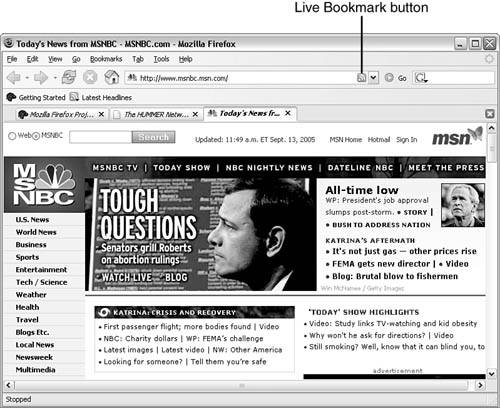
Figure 2.10. Today the MSNBC website has many Live Bookmarks. Also notice that the far right of Firefox’s location bar has the Live Bookmarks indicator/button.
Other sites might not support RSS feeds…yet! It is coming for many sites. The same site might have a standard bookmark for the page itself and a Live Bookmark for the RSS content.
No matter what symbol is displayed, clicking this button shows that you can subscribe to MSNBC - Top Stories, MSNBC - Most Viewed, or any other RSS feed the page offers. RSS feeds change frequently, so it pays to check from time to time to see whether there are any new RSS feeds on your favorite sites. When you select an RSS feed to which you want to subscribe, Firefox creates a pseudo folder in Bookmarks. That bookmark folder, when expanded, lists the content as a number of bookmarked pages the site offers. For example, I subscribed to Mozilla’s Live Bookmark Mozilla Announcements. In my bookmarks a folder is created named MSNBC - Today's News. If I open that Live Bookmark folder, I see a number of news items. From time to time, these items change, but I don’t have to update my bookmarks to reflect these changes—it is all automatic.
Note
A Live Bookmark is the pseudo folder created when you add a Live Bookmark to your bookmarks list. A Live Bookmark Article is the actual page found inside a Live Bookmark pseudo folder you open.
From our standpoint, Live Bookmarks can be treated as bookmarks. If you click a Live Bookmark, the page indicated is displayed. You don’t have to worry about the fact that these Live Bookmarks will be automatically updated as necessary.
To configure the Tabbrowser Extensions bookmark options, again you use your Preferences for Tabbrowser Extensions window.
Note
There are two ways to display the Tabbrowser Extensions window. One way is to select Tools, Extensions, Tabbrowser Extensions and click Options. The other way is to select Tab, Tabbrowser Extensions Preferences in the menu. This second way is slightly faster.
In the Category list on the left of the Preferences of Tabbrowser Extensions window, expand Use Tab and then click Bookmarks. This opens Advanced Bookmarks on the right (see Figure 2.11). You can set options for both Bookmarks and Live Bookmarks.
In the section titled Bookmarks Loading, you can set whether a bookmarked page is loaded in the current tab, a new tab, or a new tab in the background. As well, you can click the Advanced button to display the Advance Preferences of Bookmarks window (see Figure 2.12).
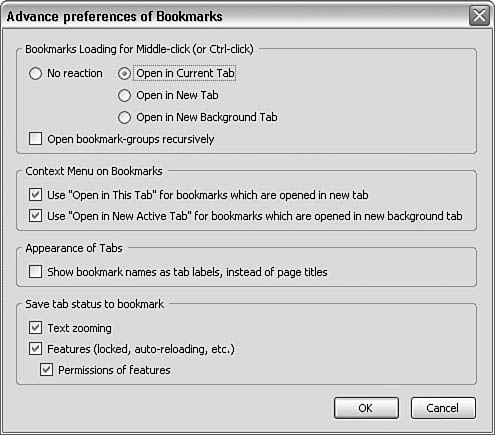
Figure 2.12. The Advance Preferences of Bookmarks window enables you to further customize how bookmarks are handled.
Configuration of middle-clicking or Ctrl-clicking enables you to either do nothing or open a bookmark. You can also choose to recursively open bookmarks if you desire by middle-clicking or Ctrl-clicking. Be sure that you understand what will happen when this option is enabled—you can open multiple tabs.
A context menu is displayed whenever you right-click an item in the Bookmarks list. This context menu is customizable as well.
When a bookmark is opened, you can choose to have either the bookmark name or the page’s title as the tab label. I personally like the bookmark name because some pages do not have sensible titles.
You can also save the tab status when saving a bookmark.
Two tabs enable you to configure the handling of Live Bookmarks. You can choose to open a Live Bookmark in the current tab, a new tab, a new background tab, or you can open all items as a bookmark group. This refers to Live Bookmarks only (again, Live Bookmarks are the folder and Live Bookmark Articles are the pages in a Live Bookmark folder).
You can choose to open a Live Bookmark article the same way as a normal bookmark is opened, in the current tab, in a new tab, or in a new background tab.
With tabs, you can have as many home pages as you want. Practically speaking, it is probably a good idea to limit the number of home pages to something manageable (in my case, I have three).
To set multiple home pages, first open each of the pages that make up your set of home pages in tabs. For example, you might open http://www.hipson.net, http://www.mozilla.org, and http://www.google.com. This gives you three tabs, one for each of these pages.
Next select Tools, Options in Firefox’s menu. In the General section at the top of the window, you can set the location or locations of the home pages you want to use (see Figure 2.13). Simply click the Use Current Pages button; whatever pages are currently displayed in the tabs become your home pages.
Note
When you have multiple home pages opened, Firefox does not look at which pages are already opened in tabs. Instead, it creates new tabs for each of the pages defined in your set of home pages.
Now whenever you click the home page button, the pages you set will be displayed.
Here are a few ideas from the experts:
Use multiple home pages. This is a great technique because it seems that no one home page covers everything.
You can easily open a new tab by double-clicking in the tab bar or pressing Ctrl-T. You can close an unneeded tab by clicking the close button at the end of the tab bar or pressing the middle mouse button.
New links can be opened by default in new tabs or by reusing the current tab.
A new tab doesn’t have to be in the foreground. A tab can be created, and loaded, while it is in the background.
Tabs are easy to manage. You can reorder your tabs using the keyboard or mouse.
Live Bookmarks and Live Bookmark Articles enable bookmarks in Firefox to respond to dynamic content.
Bookmark and use http://mozillazine.org! This site requires a free logon to post in the forums and is worth the effort.
Consider limiting the number of bookmarks in a bookmark folder to a reasonable number. I use five as my ideal maximum, but that is often exceeded.
TabGroups enable you to group, or organize, tabs by subject or content.


